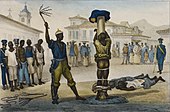
Back Càstig amb vara a Singapur Catalan Vergado en Singapuro Esperanto Castigo con vara en Singapur Spanish Makilatze zigorra Singapurren Basque Kepitysrangaistus Singaporessa Finnish Coup de canne à Singapour French Hukuman pukulan rotan di Singapura ID Fustigazione a Singapore Italian Hukuman merotan di Singapura Malay Телесные наказания в Сингапуре Russian
| Part of a series on |
| Corporal punishment |
|---|
 |
| By place |
| By implementation |
| By country |
| Court cases |
| Politics |
| Campaigns against corporal punishment |
Caning is a widely used form of corporal punishment in Singapore. It can be divided into several contexts: judicial, prison, reformatory, military, school and domestic. These practices of caning as punishment were introduced during the period of British colonial rule in Singapore.[1] Similar forms of corporal punishment are also used in some other former British colonies, including two of Singapore's neighbouring countries, Malaysia and Brunei.
Of these, judicial caning is the most severe. It is applicable to only male convicts under the age of 50 for a wide range of offences under the Criminal Procedure Code, up to a maximum of 24 strokes per trial. Always ordered in addition to a prison sentence, it is inflicted by specially trained prison staff using a long and thick rattan cane on the prisoner's bare buttocks in an enclosed area in the prison. Male criminals who were not sentenced to caning earlier in a court of law may also be punished by caning in the same way if they commit aggravated offences while serving time in prison. Similarly, male juvenile delinquents in reformatories may be punished by caning for serious offences.
Servicemen in the Singapore Armed Forces (SAF) who commit serious military offences may be sentenced by a military court to a less severe form of caning in the SAF Detention Barracks, which houses military offenders.
In a much milder form, caning is used as a disciplinary measure in schools. Boys aged between 6 and 19 may be given up to three strokes with a light rattan cane on the buttocks over clothing or the palm of the hand as a punishment for serious misconduct, often as a last resort. As the law does not allow schools to cane girls, they receive alternative forms of punishment such as detention or suspension.
A smaller cane or other implement is often used by some parents to punish their children. This practice is allowed in Singapore but not encouraged by the government. The Singaporean government has stated that in its opinion, the Convention on the Rights of the Child does not prohibit "the judicious application of corporal punishment in the best interest of the child."[2]
- ^ Cite error: The named reference
Corpun Historywas invoked but never defined (see the help page). - ^ Ratification status Archived 11 February 2014 at the Wayback Machine on the United Nations website.
© MMXXIII Rich X Search. We shall prevail. All rights reserved. Rich X Search